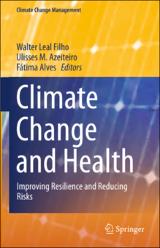Climate change and health vulnerability in Bolivian Chaco ecosystems
Fecha
2016-03-25Autor
Aparicio-Effen, Marilyn
Arana, Ivar
Aparicio, James
Ramallo, Cinthya
Bernal, Nelson
Ocampo, Mauricio
Nagy, GJ
Metadatos
Mostrar el registro completo del ítemResumen
Abstract.
Climate change and variability is impacting health, across different spatial scales, ecosystems, and water supply and quality. In Bolivia climate change is operating in a framework of poverty and inequality. This chapter focuses on the Bolivian Chaco ecosystems water availability and indigenous health. An ecohealth research was launched to evaluate rural communities and their vulnerability and impacts to current and future climate conditions. The participatory-based approach incorporates community and indigenous organizations, local and national health, and meteorological services. Main observed impacts at Chaco are water stress and warming affecting watersheds, ecosystems and health. Water-borne diseases (WBD) and diarrheal diseases (DD) affected most children evaluated. An average decrease in rainfall of 5-12 %, up to 25 % in winter, especially at the middle and low watershed, is observed. Future increases in temperature (+1-2 °C for 2030-2050), modified rainy patterns and reduced water availability are expected. The both observed and expected warming and less rainfall are correlated with diarrheal vulnerability (VCCDD)and the number of DD cases at rural and indigenous
communities. Thus, increasing trends of WBD and DD are likely for 2030-2050. This experience was useful to design Chaco region climate change policies and indigenous health adaptation strategies focused on WBD/DD. These included: raising awareness about water and health climate vulnerability and impacts, increasing investments for
water sources protection, establishing systems to compensate and protect watersheds and water springs, capacity building, WBD/DD prevention actions, and clean technologies for economic activities.

